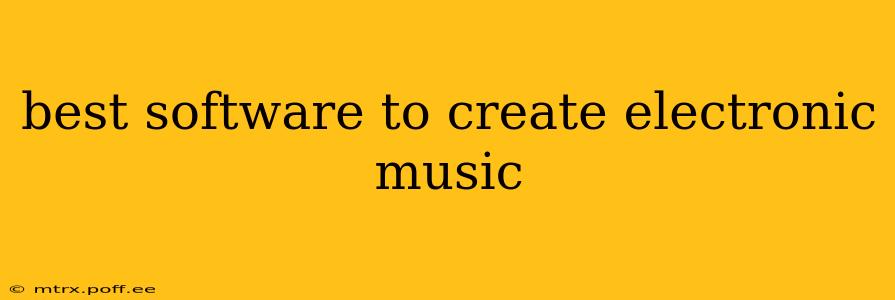Creating electronic music has never been more accessible. With a plethora of Digital Audio Workstations (DAWs) and music production software available, choosing the right one can feel overwhelming. This guide breaks down the best software options for electronic music production, catering to various skill levels and budgets. We'll cover everything from industry standards to beginner-friendly options, helping you find the perfect tool to bring your musical visions to life.
What Makes Software "Best" for Electronic Music?
Before diving into specific software, let's define what constitutes the "best" choice. The ideal software depends heavily on your individual needs:
- Your Skill Level: Are you a complete beginner or a seasoned producer? Some DAWs boast intuitive interfaces for newcomers, while others offer advanced features for experienced users.
- Your Budget: Prices range from free to thousands of dollars. Consider your budget and whether you're willing to invest in subscriptions or one-time purchases.
- Your Genre: Different genres may benefit from specific features. For example, a trance producer might prioritize a strong synthesizer collection, while a hip-hop producer might need robust sampling tools.
- Your Operating System: Ensure the software is compatible with your Mac or PC.
Top DAWs for Electronic Music Production
Here are some of the leading DAWs used by electronic music producers worldwide, categorized for clarity:
Industry Standards:
- Ableton Live: Known for its intuitive workflow, powerful MIDI capabilities, and excellent session view, perfect for live performance and looping. Ableton is a favorite among many electronic music artists, particularly those focusing on genres like house, techno, and drum & bass. It's also incredibly versatile, able to handle various genres.
- Logic Pro X: (Mac only) A comprehensive DAW packed with a vast array of virtual instruments, effects, and features. Its user-friendly interface and extensive library make it a great choice for both beginners and professionals. Logic Pro X excels in various genres, including electronic, hip-hop, and orchestral.
- FL Studio: Boasting a long history and a dedicated user base, FL Studio stands out for its pattern-based sequencer and extensive plugin support. It's a popular choice for hip-hop, trap, and EDM production due to its intuitive workflow and powerful features.
Beginner-Friendly Options:
- GarageBand: (Mac and iOS) A free DAW included with macOS and iOS, GarageBand is perfect for beginners. While lacking the advanced features of professional DAWs, it's a fantastic starting point for learning the fundamentals of music production. It offers a simplified interface and a basic selection of instruments and effects.
- Cakewalk by BandLab: (PC) This free DAW is a powerful contender, offering a surprisingly comprehensive feature set without the price tag. It's a great alternative to paid software for those starting their electronic music journey. It provides a strong selection of tools for creating various styles of electronic music.
Other Notable Options:
- Cubase: Renowned for its precision and stability, Cubase is a highly regarded DAW used by professionals across various genres.
- Studio One: Boasting a streamlined workflow and a powerful feature set, Studio One is a strong alternative to other industry standards.
H2: What are the best free electronic music software options?
Several excellent free options are available, though they often have limitations compared to their paid counterparts. GarageBand and Cakewalk by BandLab are the strongest contenders, offering surprisingly robust features. Other free options may offer limited functionality or require subscriptions for full access to features. The quality of free software varies greatly, so it's crucial to research before committing. Don't be surprised if you outgrow a free DAW and decide to upgrade as you become more experienced.
H2: What software do professional electronic music producers use?
Professional electronic music producers use a variety of DAWs. Ableton Live, Logic Pro X, FL Studio, and Cubase are extremely popular choices, although the "best" choice comes down to personal preference and workflow. Many professionals will use a combination of DAWs depending on the project and the type of electronic music they're creating.
H2: Which software is best for beginners?
For beginners, GarageBand (Mac and iOS) and Cakewalk by BandLab (PC) are excellent choices due to their user-friendly interfaces and free price points. They offer sufficient tools to learn the basics of music production without a steep learning curve. As you progress, you may eventually want to upgrade to a more advanced DAW.
H3: Which DAW has the best synths?
This is entirely subjective; many DAWs and individual plugins offer incredible synthesizers. Some DAWs like Logic Pro X and Ableton Live come with a wide variety of built-in synths, while others have excellent capabilities to host external VST instruments. Research the included synths or the plugin compatibility before choosing.
Conclusion
Selecting the best software for creating electronic music hinges on your individual needs. Consider your skill level, budget, preferred genre, and operating system to make an informed decision. Start by exploring free options like GarageBand or Cakewalk by BandLab to learn the ropes, then consider upgrading to a professional DAW like Ableton Live, Logic Pro X, or FL Studio as your skills and ambitions grow. The most important thing is to find the software that inspires you to create music.
